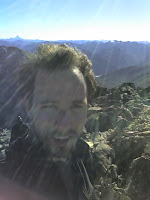
This is rock climbing. I have 35-40lbs on my back, big trekking boots, no rope and I'm 50ft up a cliff. There's black ice on the rock face. Next, 2 week old iced up snow lies across the track (such as it is). To step on it would mean a fast slide down the mountain. So we skirt round the top of it, find some rocks to climb up and head on. Actually, I start to climb a sheer rock face, lose my nerve and remain stranded. I don't know how to get up or down. I ask Bailey for advice. He managed it no problem. He's trying to help but can't remember what he did. Besides from the top you can't see the rock face. I take a minute. Shut out everything. Decide that I'm not going to spend the night here then find a way up.
On to the next pass. Hop over and along. Then, instead of passing below Cerro Inocentes, we go the wrong way, climb to the peak, go over to the other side and clamber down before realising we're in the wrong valley. Back up. My climbing is getting better but it's challenging me. Along to Cerro Navidad. And what an amazing view of Mt Tronador. At 3,500m, it's the tallest mountain in the region. An extinct volcano, its slopes are covered in glaciers that keep it white all year round. I switch on my phone to take a couple of quick snaps. In view of Bariloche, way over to the North East, 2 text messages come through. I can't reply, though.
A condor flies overhead, checking us out. Finally, the long steep descent. Tough and a little monotonous. Then straight ahead on the other side of the valley we can see the path, a series of switchbacks climbing a near vertical 400m. That will take us to Laguna Negra, where we're stopping for the night. There is the option of camping at the valley floor. Tough choice. Take the climb and stay in a refugio or stop earlier and camp at the bottom?
We reach the start of the ascent at 6.30pm. Last light, we were told at Jakob, is at 7pm. Already the sun is behind the mountains. Bailey races up. I try to keep up but can't. He's way better at this than me. But I'm feeling grateful to Signa for making me do all those deadlifts and power squats. The strength in my back and legs from it is helping.
I'm dehydrated. Gasping for water, I drive myself on, telling myself how much beautiful mountain water I'll drink when I get to the top. This is the reward I'm offering myself for keeping going. I should have stopped for a quick drink, really, but make the wrong decision to plough on. I have to make it before dark. Light is fading fast and my legs are starting to give in. First my right quad starts cramping. I guess my body compensates and puts additional strain on other muscles. My left calf goes, then the right. I'm in pain. I push on. I'm telling myself to push for 2 minutes. Then another 2. And on. I can see I'm nearing the top but each time, there's another switchback and more climbing. Finally, I reach the top. 7.12pm. Not quite dark. Just ambient light left.
Bailey's fetching water from the stream. "There's already a fire going in there", he tells me. Inside there's a number of others. 6 Argentinians and a Dane, living in Bariloche. There's a couple from Ushuaia, although he's originally from Bariloche and has come back to join in the festivities for Bariloche's Birthday on 3rd May. Two girls from Bariloche. A school age local girl and boy. Her father runs the old refugio on Mt Tronador. And the Dane, who came over to do the ski season last year and has stayed on. We spend the next few hours chatting, cooking, sharing stories and mate. I'm so hungry, I eat 250g of pasta and 250g of tomatoes, half a packet of biscuits and an apple. At least the pack will be lighter tomorrow.
My legs are bad. After eating, they start to cramp. I don't sleep well. At least it's warm and pleasant. Tomorrow is the easy descent to Punto Lopez.



